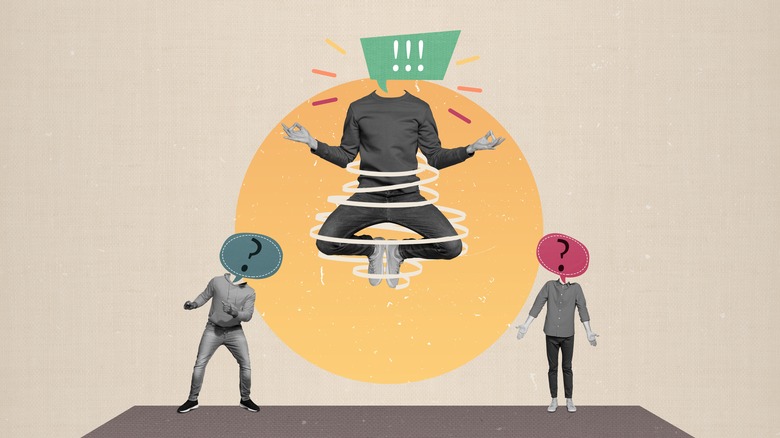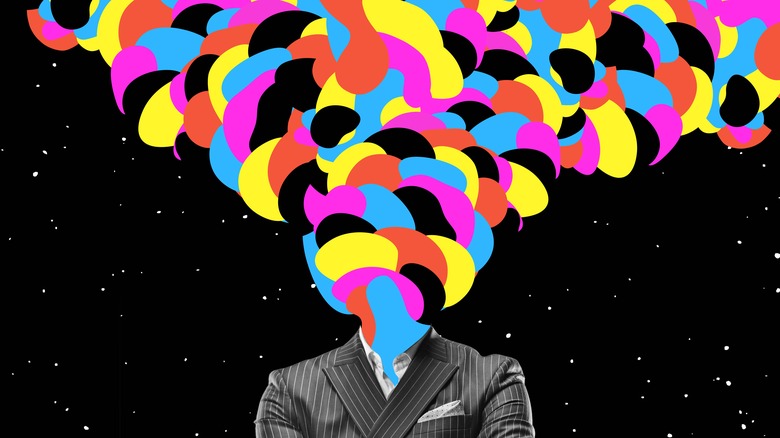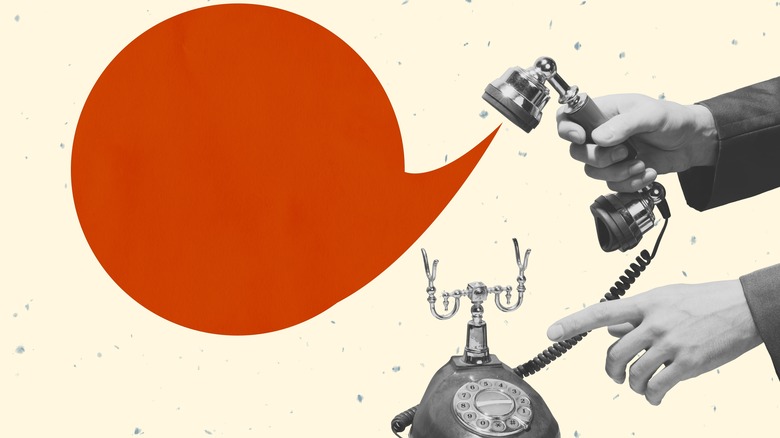These Theories Will Change The Way You Think About Dreaming
So you remember that one dream where you rescued a baby marmoset from a Victorian torture dungeon full of brass-rimmed mirrors reflecting faces that weren't yours? And you flew up and over the grasping hands of the hill giants of Loth'ka Mor and into a school bus brimming with lava that didn't burn when you waded through it? And the bus drove along a cliff edge by a ravine full of moistened pizza dough waiting for the bus to tip over and pour down its lava-like sauce if only you let the marmoset assassinate the lizardman bus driver who speaks with a Cockney accent? And ... wait a second. You're telling me that the pizza dough represents lost maternal love? Neat!
Yes, dreams can get a bit bizarre. They follow their own logic, seem full of abstract occurrences or physically impossible scenarios, and are sometimes disturbing. Or you might be amongst those who dream of mundane things like grocery shopping and sweeping the floor. But regardless of specific dream imagery and elements, people have always been fascinated by dreams and attached meaning to them. Ancient Greeks took dreams as messages from the gods and the afterlife conjured by Morpheus, son of Hypnos (sleep), who was the son of Nyx (night). Folks in ancient China interpreted dreams similarly and took their meanings as indicating prosperity or doom. And even in the realm of modern psychology, dreams still take on a multitude of meanings.
It's all symbolic
When thinking of the psychology of dreams, everyone's favorite cigar-smoking, late-19th-century psychotherapist Sigmund Freud is likely to come to mind. Speaking of long cylindrical objects like cigars, the very maternally-attached Freud (another story) would say that such an item represents a penis, as Psychology Today explains. Additional phallic symbols — there are a lot — include knives, umbrellas, tall buildings, and things that pour liquid. And you think that's a king in your dreams? Oh no, that's your father come to dominate you and repress your sexual desire for your mother. Water, in Freudian psychoanalysis, is shorthand for birth, while journeys mean death, clothing indicates vulnerability, small rodents represent children, and much more.
No matter how much you buy into Freud's very specific psychosexual interpretation of dreams, his impact within and without the world of psychology has been absolutely immense. At this point, is it possible to talk about human motivation by discussing the unconscious, that bundle of below-the-surface fears, hates, and desires that propel our conscious decision-making? Probably not. GoodTherapy says that Freud called dreams "the royal road" to the unconscious, like an unfettered pathway revealing truth. He wrote about this and more in his 1900 "The Interpretation of Dreams," from which we get his particular, sexually-focused method of dream analysis. But even if someone finds Freud's preoccupations off-putting, dreams can still be an assortment of symbolic images and situations meant to convey information abstractly — and which are open to interpretation.
Coming to decisions
So here's a dream for you: You're being chased by a big ole' dinosaur with a massive jaw full of saliva-slathered teeth. You're racing down a woodland path that forks ahead to the right and left. On the left is a fortress behind a gate, and on the right is a hilltop with a bunch of medieval weapons at the summit. Do you huddle in the safe-looking but weaponless fortress or scale the defenseless summit and grab a spiky mace? Also: that morning you got wind of two potential job offers — one safe and the other risky. But you've got to hurry to make a decision. Hmm ... any wonder what's up with the meaning of the dream?
In a nutshell, this is what Verywell Mind calls emotional regulation dream theory. Lots of theories of dreaming assume that dreams are some output of neurological data processing, but this one is different because it assumes that dreams do have coherent value. They're a method of making sense of what happens in the waking world, but in a safe, contained place — kind of like you're own personal problem-solving chamber. This makes dreams — and their stories and symbolism — more of a continuation of waking thought than anything else, and the waking world a continuation of dreaming. This also, in agreement with Freud, makes dreams symbolic. But very unlike Freud, dreams aren't general representations of unconscious psychosexual desires but the mind deliberately pondering particular, conscious questions.
Just a bunch of garbage
Then there's the opposite perspective: dreams are just a bunch of neurological trash. They're the output of chemical sputters and electrical surges that the sleeping mind attempts to synthesize into something cohesive, aka a dream. This idea was first postulated in 1977 by psychiatrists J. Allan Hobson and Robert McCarley, who coined "activation-synthesis theory" to describe their research, as Practical Psychology explains. Verywell Mind goes into more detail, describing how the brain engages in various clean-up processes during sleep and how this may contribute to ideas, memories, thoughts, etc., firing off in a haphazard fashion. This happens when the limbic system becomes more active during sleep — particularly the brain's amygdala and hippocampus.
There's another related dream theory that goes one step further toward declaring dreams meaningless. According to physiological-functioning theory, it's true that dreams are the by-product of sleep-time cleanup processes, similar to how a car needs to run periodically so that the engine doesn't die. But according to this theory, there's no attempt on the mind's part to synthesize information — it's all random noise. This theory itself could fit under the umbrella of yet another theory called the continual activation theory of dreams, described on Dreaming Life. As its name implies, the theory defines dreams as part of general, ongoing "data transfer" activity, particularly related to memory storage. In other words, dreams are a mundane biological output, like urine of the mind.
Processing information
Along the lines of continual activation theory but possibly even more mechanically oriented sits information processing theory, and it also connects to dreams. In case you haven't noticed, lots of terminology in modern-day dream theory — and modern psychology by extension — analogizes the human brain to a computer. This makes sense because we live in a time all but defined by computer usage, same as how Sigmund Freud analogized the human mind to a bottled-up steam engine during the Industrial Revolution. Under information processing theory, as Practical Psychology explains, a brain is essentially a data-driven input-output machine conditioned to learn and perform certain tasks — that's it. It's through this lens we can look at dreams.
Information processing theory gives rise to the self-organizational model of biological systems, which doesn't concern itself with the content or meaning of dreams — only with the cognitive processes that give rise to dreams. As a 2013 article published on Frontiers in Psychology explains, dreams occur when there is tension between the demands expected of a biological system (a person) and that system's environment (life, work, relationships, etc.). The system attempts to "self-organize" its previously learned conditions — particularly as related to specific memories and experiences — into a revised version of itself able to cope with environmental demands. In essence, this could be seen as a cognitive-behavioral psychologist's ultra-technical version of emotional regulation dream theory, where dreams, simply put, result from people thinking about how to resolve a situation in their lives.
Running a threat simulation
As the reader might have noticed, a lot of theories of dreaming are interconnected, even a bit hard to distinguish. This is because different researchers do research at different times, and each endeavor builds on previous research. Plus, it pays (literally) for researchers to stand out from their peers by proclaiming they've got a new theory about something — particularly if that theory comes with a clever-sounding name. A lot of dream theories are borderline unverifiable and difficult to qualify as science (like Freud), while others are so austere as to strip away all the mystery of dreams and transform a person into a fleshy bag of cellular interactions.
And so, we've saved a different middle-of-the-road explanation of dreaming for last: threat-simulation theory, and by extension social simulation theory, as Practical Psychology describes. Have you ever caught yourself daydreaming about how a catastrophe or potentially uncomfortable social situation would play out? For instance, what you would do if your partner got hit by a car on the way home from work, or how a first conversation with a new co-worker would go? This is normal, and all folks do this to some extent. According to threat-simulation theory, explained a bit more in a study published on ScienceDirect, this is exactly what dreams are. They are a form of role-play that runs through survival scenarios to help you prepare for potential threats and novel situations. Maybe that's why your dog always looks like it's chasing something while dreaming.





